Magnetic Variations – I Setting the scene
The magnetic compass was an important navigation instrument in the Early Modern Period, but it was not without its problems. In the last third of the sixteenth century a group of English navigators and scholars cooperated loosely in efforts to understand how the magnetic compass actually worked and to see if the known problems could be solved. The most famous of them was the physician William Gilbert[1] (1544?–1603), who published his ground-breaking De Magnete in 1600, an oft overlooked major contribution to the emergence of modern science in the seventeenth century.
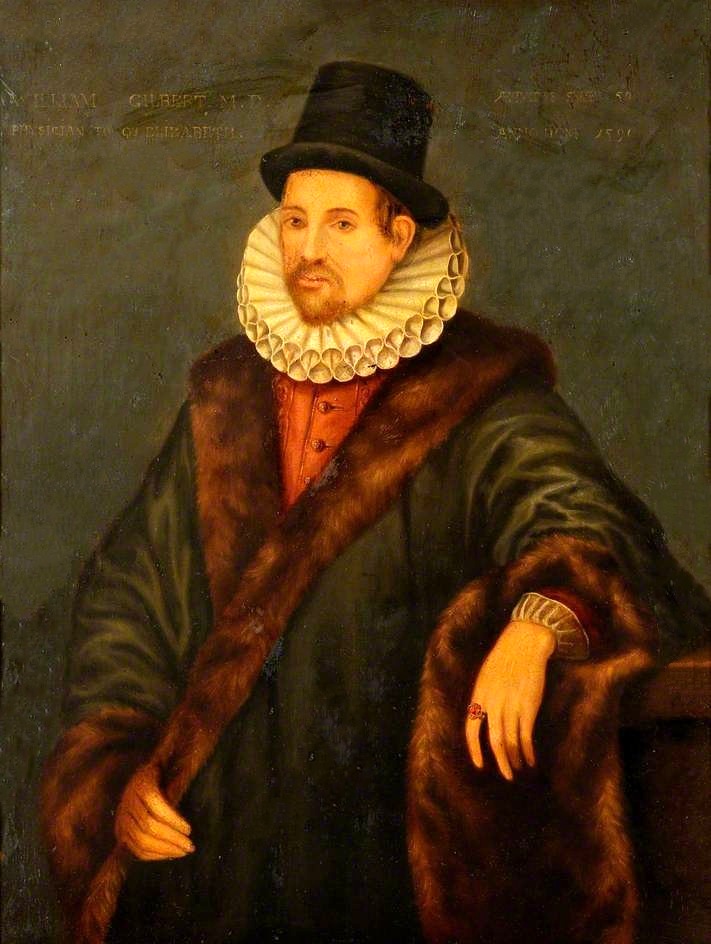
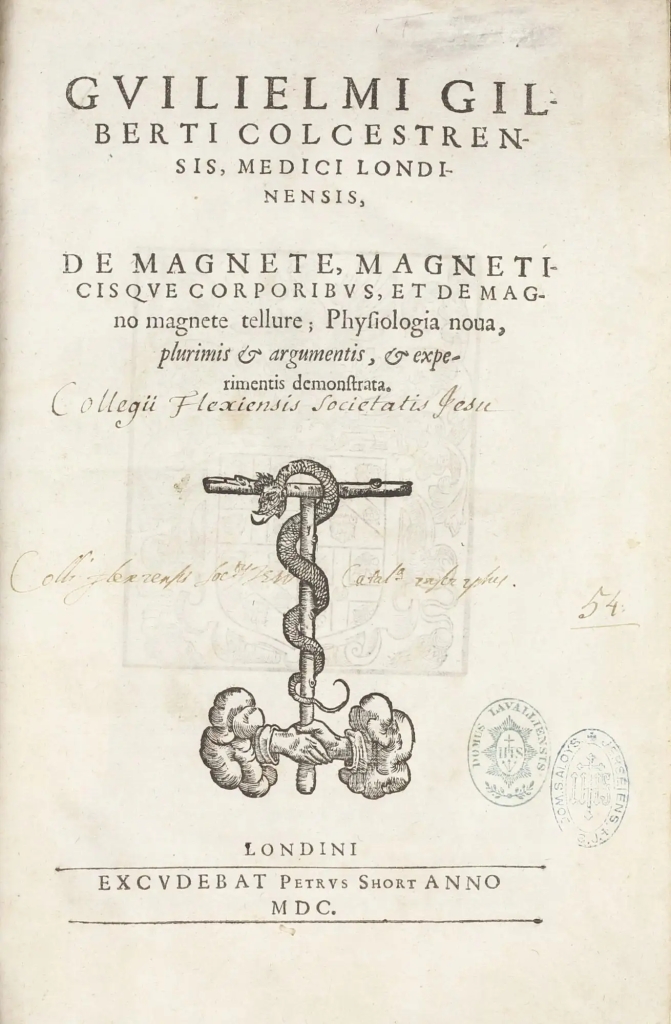
But Gilbert was by no means alone and as he himself acknowledges, in Book I Chapter I of his masterpiece, his work rests on the shoulders of a significant number of his countrymen:
There are other learned men who on long sea voyages have observed the difference of magnetic variation[2]; as that most accomplished scholar Thomas Harriot, Robert Hues, Edward Wright, Abraham Kendall, all Englishmen; others have invented and published magnetic instruments and already methods of observing, necessary for mariners and those who make long voyages: as William Borough in his little work the Variations of the Compass, William Barlo (Barlow) in his Supplement, Robert Norman in his New Attractive–the same Robert Norman, skilled navigator and ingenious artificer, who first discovered the dip[3] of the magnetic needle.[4]
Before I tackle Gilbert’s list of Englishmen, who contributed to the history of our understanding of magnetism and the magnetic compass, this episode will briefly deal with the history of the topic before the late sixteenth century.
We only know about magnetism because there are naturally occurring magnets. These are magnetised pieces of the mineral magnetite an iron ore with the chemical formula Fe2+(Fe3+)2O4, which when magnetised is known as lodestone. Magnetite is not naturally magnetic, and it is not actually known how pieces of magnetite become magnetised. The earth’s magnetic field is too weak to magnetise them, and the generally accepted theory is that they become magnetised by lightning strikes, a theory that is strengthened by the fact that lodestone is only found on or near the surface of the earth.
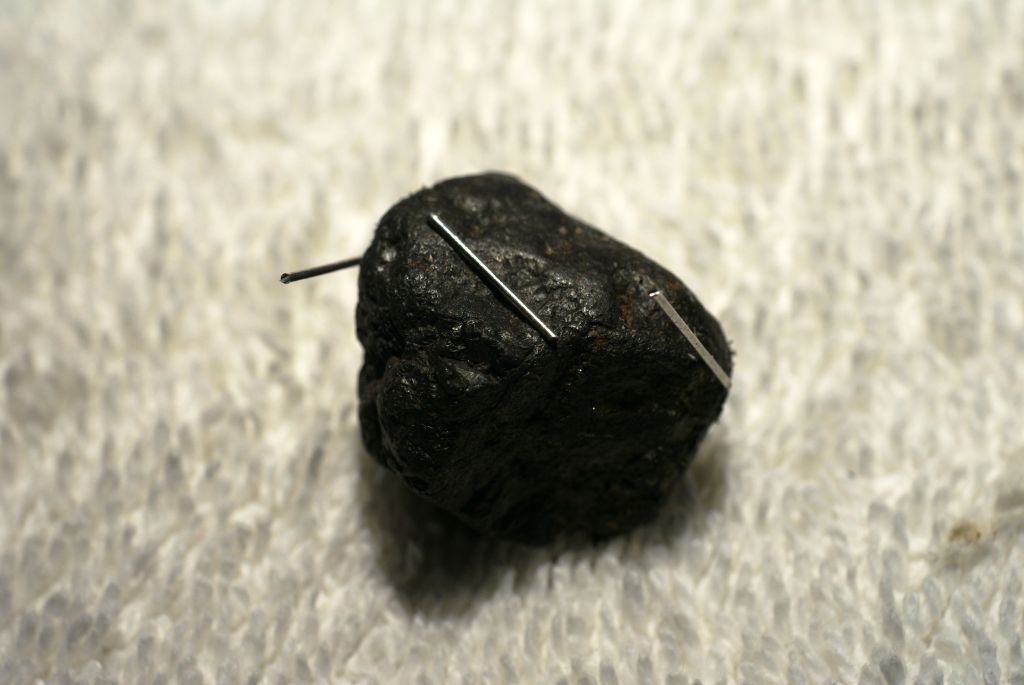
The discovery of the magnetic property of lodestone by the Greeks is traditionally attributed to Thales (c. 624–c. 547 BCE) but as usually we have nothing on the topic from Thales himself. Aristotle (384–322 BCE), who in his On the Soul wrote:
Thales, too, to judge from what is recorded about him, seems to have held soul to be a motive force, since he said that the magnet has a soul in it because it moves the iron.
Not exactly very informative. The earliest Chinese reference to magnetism is in the fourth-century BCE book Guiguzi, a collection of texts on rhetoric, named after its supposed author. The second-century annals Lüshi Chunqiu notes, the lodestone makes iron approach; some (force) is attracting it. The earliest mention of the attraction of a needle is in the first-century work Lunheng, A lodestone attracts a needle.
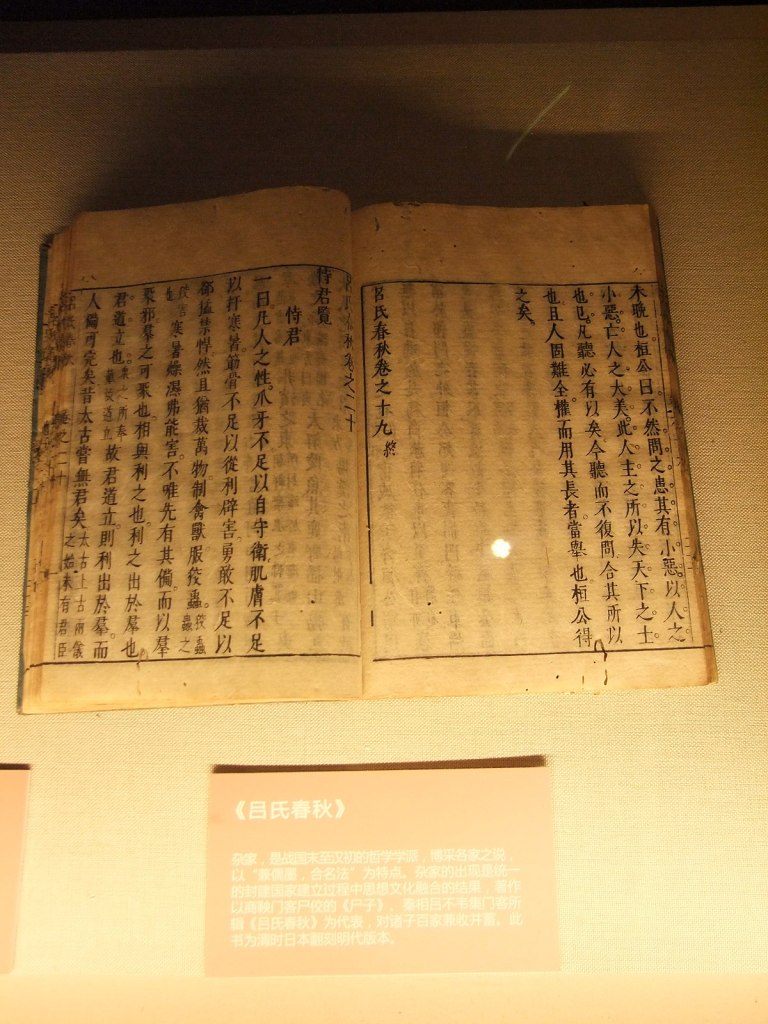
The earliest know compass was invented by the Chinese sometime between the second-century BCE and the first-century CE. This was not used for navigation by for geomancy and divination. They were almost certainly used in feng shui an ancient Chines practice which claims to use energy forces to harmonise individuals with their surrounding environment. In the Lunheng is the first reference to a spoon, thought to be made of lodestone pointing in a cardinal direction, but when the south-pointing spoon is thrown upon the ground, it comes to rest pointing south.
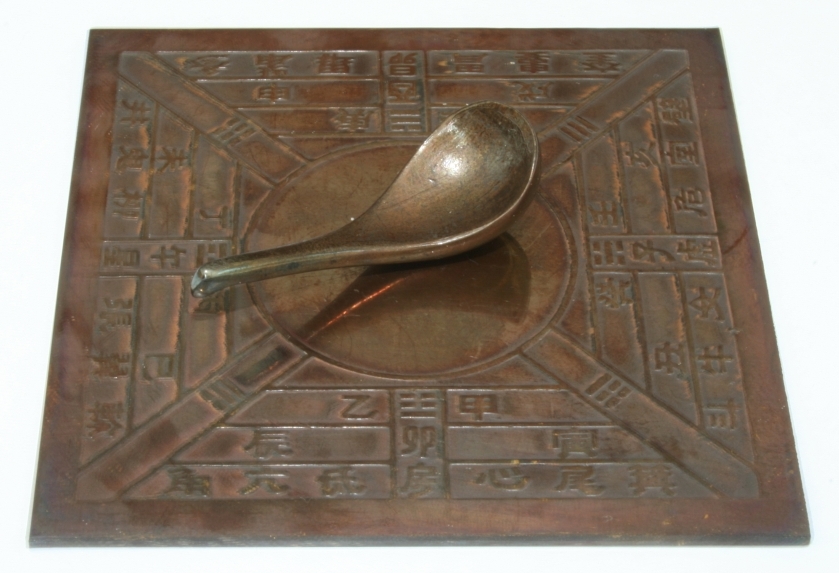
The earliest Chinese reference to a magnetised needle is from the Dream Pool Essay (1088) written by the polymath Shen Kuo (1031–195). The earliest Chinese reference to the use of a magnetic compass on land for navigation dates to sometime before 1044 CE, and the first clear evidence of the use of the compass in maritime navigation is from Pingchow Table Talks (dated 1111 to 1117) by the maritime historian, Zhu Yu (960–1279).
The English theologian and writer, Alexander Neckam (1157–1217) published the earliest European reference to the use of the magnetic compass for navigation in his De naturis rerum written between 1187 and 1202:
The sailors, moreover, as they sail over the sea, when in cloudy whether they can no longer profit by the light of the sun, or when the world is wrapped up in the darkness of the shades of night, and they are ignorant to what point of the compass their ship’s course is directed, they touch the magnet with a needle, which (the needle) is whirled round in a circle until, when its motion ceases, its point looks direct to the north.
The earliest known reference to the use of the magnetic compass in navigation in the Muslim world was in the Jawāmi ul-Hikāyāt, a collection of stories from 1232. The reference is to a fish-shaped iron leaf, a typical early Chinese design, indicating a technology transfer. The earliest reference to a compass in the form of a magnetic needle floating in a bowl of water is in a book by Baylak al-Qibjāqī (fl. 1240–1282) written in 1282, relating a voyage he took from Syria to Alexandria in 1242. The Yemini astronomer Al‐Ashraf Umar (c. 1242–1296) wrote the first description of the use of a magnetic compass to determine the qibla (the direction of Mecca for prayer) in a text on astrolabes and sundials late in the thirteenth century.
Of interest is the fact that the Muslim use of the compass is fairly obviously a technology transfer from China, but the first known occurrence postdates the first reference for its use in Europe. Normally, in the Middle Ages, Europe acquired Chinese technology via the Muslim world. In this instance it appears not to be the case. It has suggested that, as with the invention of printing with movable type, that the European use of the compass was an independent reinvention.
Probably the most extraordinary document in the whole history of magnetism and the magnetic compass is the Epistola Petri Peregrini de Maricourt ad Sygerum de Foucaucourt, militem, de magnete (Letter of Peter the Pilgrim of Maricourt to Sygerus of Foucaucourt, Soldier, on the Magnet), one copy of the manuscript of which closes with Actum in castris in obsidione Luceriæ anno domini 1269º 8º die augusti (Done in camp during the siege of Lucera, August 8, 1269). Other than the information contained in the title and in the closing statement, we know absolutely nothing about Petrus Peregrinus or how he came to write is Epistola de magnete, as he and his text are commonly known. Despite the date and although it contains some unsubstantiated speculation this is a scientific study of the magnet and its application as a compass.
The Epistola is in two books the first having ten chapters and the second three. The first book describes the properties and effects of the lodestone. Peregrinus ignores all considerations of its occult powers. He was the first person to emphasise the bipolarity of the magnet and was probably the first to use the word polus (pole) for the magnet in analogy to the celestial poles with which, in his opinion, the free rotating lodestone aligns. Just as the celestial sphere has a north and south pole, so also does every magnet. Having suggested to Sygerus, the addressee of the Epistola, that he shape his lodestone like a sphere, Gilbert would later use the name terrella for such a magnet, he gives a method of finding the poles using an iron needle, basically using it to trace the lines of longitude on his sphere, the poles being where the lines cross.
Having found the poles, he then describes how by floating the magnet in a bowl of water one can distinguish the north and south poles. He describes the effect of one magnet on another, like poles repelling, unlike attracting. Having demonstrated that a magnet divided in the middle becomes two magnets he then correctly concludes that each part of a magnet is itself a magnet. There is more of the same, descriptions of the basic properties of the magnet, how to magnetise an iron needle etc in the first book.
In the second book he describes how to construct both the wet and dry compasses. The wet compass being a bowl of water in which a lodestone encased in a wooden sheath is floated. The dry compass if a magnetised needle pivoted on a pin in a bowl. For both bowls he suggests a transparent cover with graduations marking the cardinal points, to make reading off directions easier. The third chapter of the second book describes his attempt at constructing a magnetic perpetual motion machine.
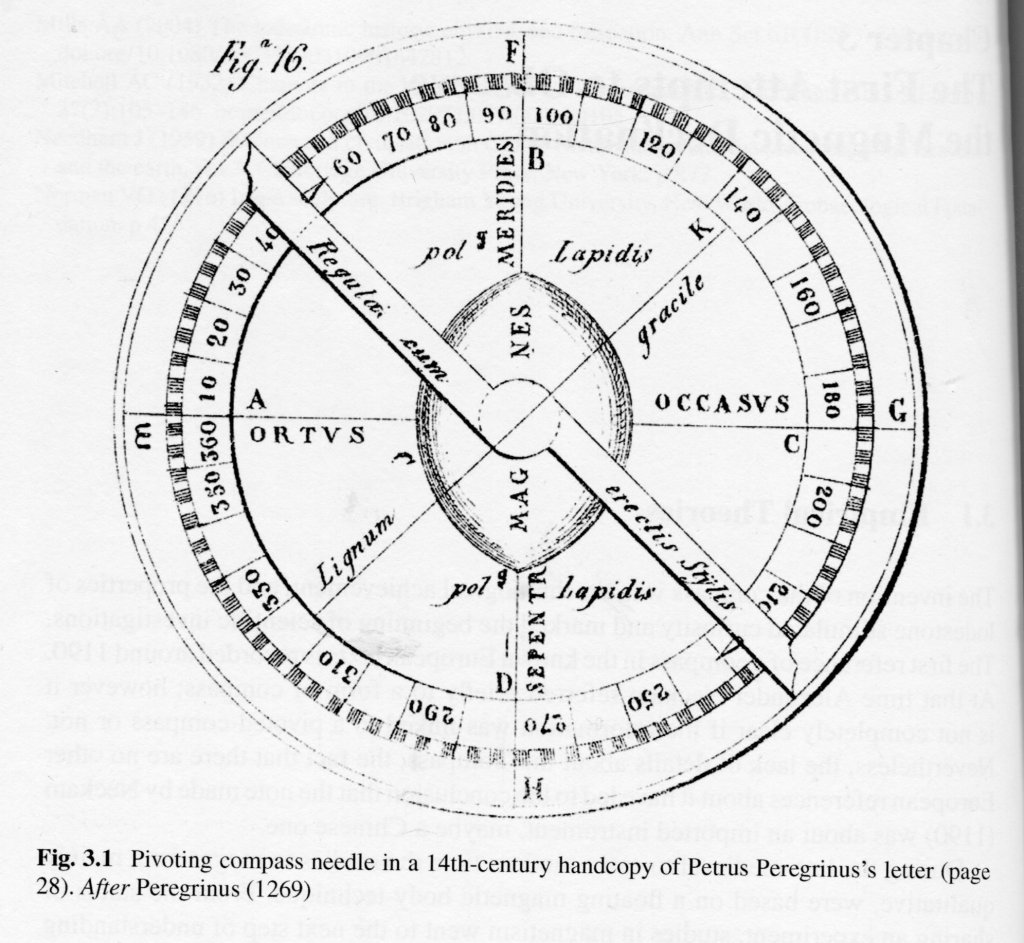
There would not be another comparable study of the magnet, magnetism, and the magnetic compass until Gilbert wrote and published his own De Magnete in 1600, which borrowed much from Peregrinus, some of it acknowledged and some not.
Having established the history of the invention of the magnetic compass and the beginnings of its use for navigation, a brief note on its function. Nobody actually knew how or why the compass needle came to rest pointing along a north-south axis. Various unsubstantiated explanations were offered. Most common was that the compass needle pointed either to the North Celestial Pole or to the Pole star. For example, Peregrinus looked to the heavens in the belief that the poles of a magnet receive their virtue from the celestial poles. Other suggestions were an unknown island or an unknown magnetic mountain. Mercator’s largely fantasy map of the Arctic featured a Rupes Nigra (Black Rock) a phantom island believed to be a black rock located at theMagnetic North Pole or at the North Pole itself. Described by Mercator as 33 “French” miles in size, it purportedly explained why all compasses point to this location (Wikipedia).
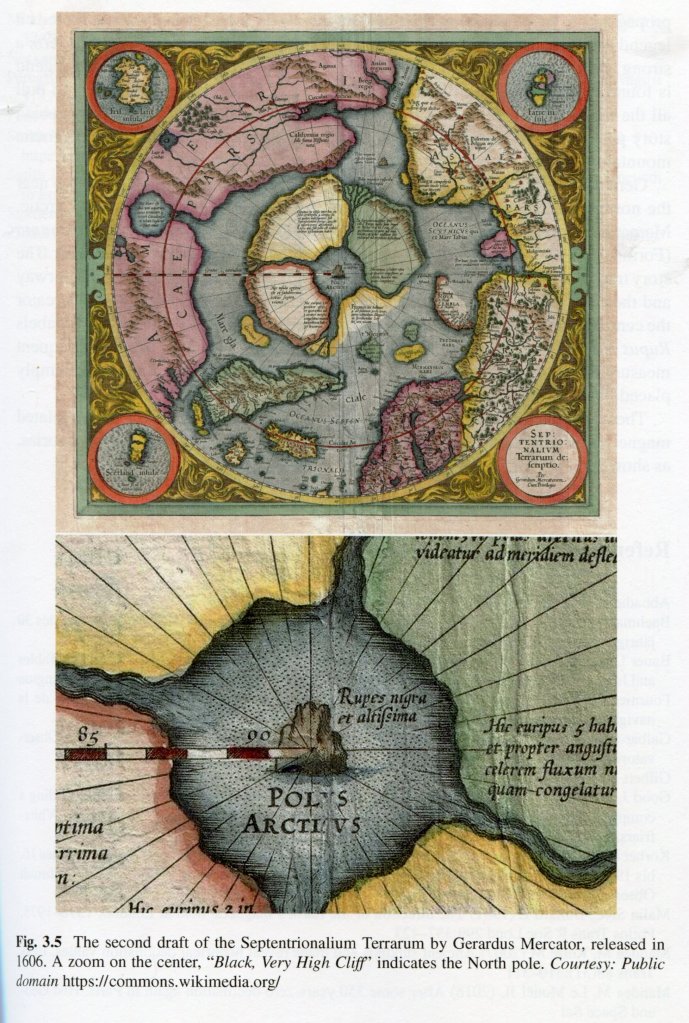
Not long after Alexander Neckam’s description of the wet compass, in about 1240, the Belgian theologian Thomas of Cantimpré (1201–1271), a student of Albertus Magnus (c.1200–1280) and friend of Thomas Aquinas (1225–1274), wrote an account of mariners magnetising a needle and constructing a wet compass:
When clouds prevent sailors from seeing Sun or stars, they take a needle and press its point on the magnetic stone. Then they transfix it through a piece of straw and place it in a basin of water. The stone is then moved round and round the basin faster and faster until the needle, which follows it, is whirling swiftly. At that point the stone is suddenly snatched away, and the needle points towards the Stella Maris. From that position it does not move.
Stella Maris is an alternative name for Polaris or the Pole Star, which is associated with the Virgin Mary, so Thomas thought the compass needle pointed to the Pole Star.
Although they didn’t really know how or why it worked, European navigators at the beginning of the Early Modern Period, as they first began to venture out onto the high seas from the Iberian Peninsula, had a new tool that helped them orientate whilst out on the oceans. This instrument could help them find north and thus determine their sailing direction when the Sun and the stars were not visible. However, as they soon discovered there was a catch, isn’t there always. That catch is what we now call magnetic declination or as they knew it, magnetic variation.
What is magnetic variation? Magnetic variation is the fact that a compass needle does not actually point in the direction of the terrestrial North Pole but to a point some degrees distant from it. This would not be so slim if the amount of magnetic variation was constant, but it varies quite substantially depending on where you are on the earth’s surface, and as we will learn later in this series with time. That means if you determine the magnetic variation for say London in the year 2000 you will get a different value for it when you redetermine it in 2020. This makes the normal magnetic compass not the most reliable of navigation instruments.
As with almost all basic things magnetic, the Chinese are credited with being the first the discover magnetic variation sometime between 800 and 1100 CE. It is not known exactly when the Europeans first became aware of it but the earliest evidence that they had acquired that knowledge is on the compass of a portable sundial made by Georg von Peuerbach (1433–1461) in Vienna in 1451.
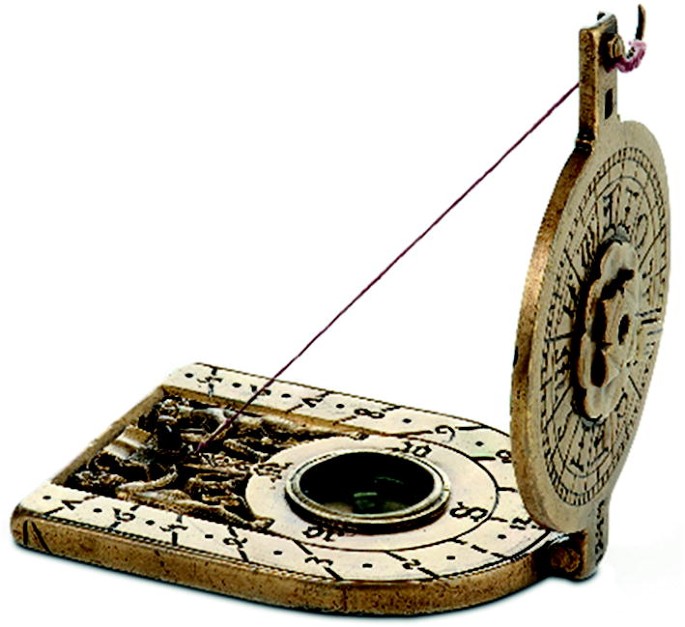
Portable sundials have a built-in compass to enable the user to orientate them correctly for use. Peuerbach’s 1451 portable sundial is the earliest known with a built-in compass. Other portable sundials from the period from Southern German, most notably Nürnberg, also were adjusted for magnetic variation with an average value of 10°E of true north.
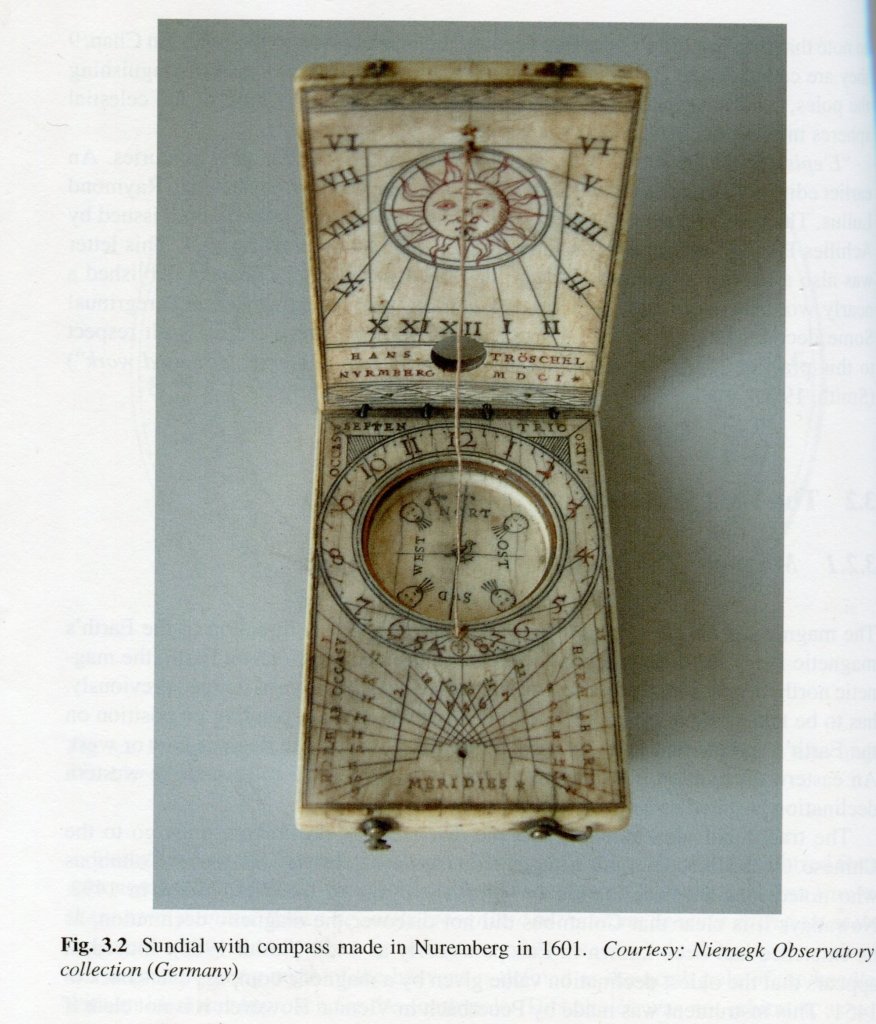
The compass makers of Antwerp obviously didn’t really understand variation and simply adopted the Nürnberg value for their compasses gluing the compass needle to the compass card offset by about 10°E. Awareness of variation obviously began to spread and the compass makers of Genoa began to follow the Antwerp model but with the needle offset only by 5°E.
Around 1500 the awareness of magnetic variation began to appear on maps. The famous 1500 Rome Pilgrimage Route Map of Erhard Etzlaub, the Nürnberger sundial maker, has a compass rose at the bottom with the variation marked on it.

Both the 1544 world map of Sebastian Cabot (c. 1474–c. 1557) and that of Gerard Mercator (1512–1594) from 1569 had information about magnetic variation in their cartouches.
The early Portuguese explorers only sailed down the coast of Africa, so the changes in magnetic variation initially did not play a significant role. However, as the Iberian explorers, beginning with Columbus in 1492, began to cross the Atlantic confusion set in together with a completely false hypothesis. The standard method of crossing the Atlantic was to sail down a latitude. To do this, a navigator sailed up or down the coast of Europe or Africa until the reached the latitude of their intended destination in the Americas. They then turned through ninety degrees and sailed across the ocean on that latitude. It was not the shortest route but in terms of not getting lost on the ocean the safest. Doing this they could measure how the magnetic variation varied as they sailed across. Then came a major shock. Up till now all magnetic variations determined in Europe had been east of true north. Suddenly east of the Azores they measured variations west of true north. E of true north variation became known as positive and W of true north negative variations. Also, around the longitude of the Azores they had made measurements of zero variation.
These discoveries led to João de Lisboa (c. 1470–1525) and Pedro Anes (c. 1475–?) putting forward the hypothesis in 1508, which João de Lisboa then published in his Tratado da agulha de marear (Treatise on the Nautical Compass) in 1514, that the true Azores meridian (25°W of Greenwich) was a zero meridian of magnetic variation and if one sailed 90°E or W of the Azores the variation would gradually rise to 45°. Here was a solution to the longitude problem! The measurements of variation that didn’t at least approximately fit this hypothesis were dismissed as operator or instrument error. This was widely accepted as there was a widespread belief anyway that variation didn’t really exist but was the product of operator or instrument error. Magnetic needles incorrectly mounted, lodestone by magnetisation wrongly applied, and so on and so forth. Perhaps surprisingly João de Lisboa’s theory became widely accepted in the Iberian Peninsula and was still going strong at the end of the sixteenth century, although already discredited. One major stumbling block for his theory is that when the Portuguese finally rounded the southern tip of Africa the compass needles swung wildly and also began to display W of true north variations. These were dismissed as the influence of a magnetic mountain. In Portuguese the Cape of Good Hope was called the Cap de Agulhas, the Cape of the Compass Needles!
In 1529, Pedro Nunes (1509–1578) was appointed Royal Cosmographer of Portugal and in 1537 professor for mathematics on the newly established University of Coimbra.
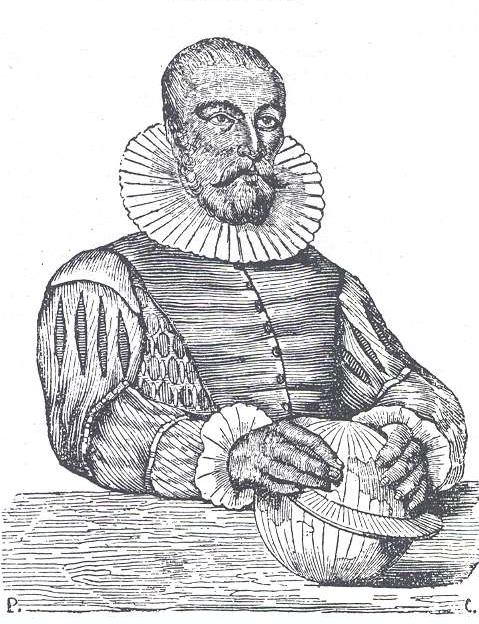
In 1537, he published both Tratado em defensam da carta de marear (Treatise Defending the Sea Chart) and Tratado sobre certas dúvidas da navegação (Treatise about some Navigational Doubts), containing his proof that a course of constant compass bearing on the globe is not a great circle but a spiral known as a loxodrome. He also argued that on a sea chart the meridians and parallels should be straight lines perpendicular to each other. This is, of course the information out of which Mercator constructed his 1569 chart. In 1546, Nunes also published a book on navigation in Latin, his De arte atque ratione navigandi, making his ideas available to a wider audience including William Gilbert. Nunes also invented a ‘shadow instrument,’ which made possible combined observation of magnetic direction and solar altitude. He trained navigators in its use.
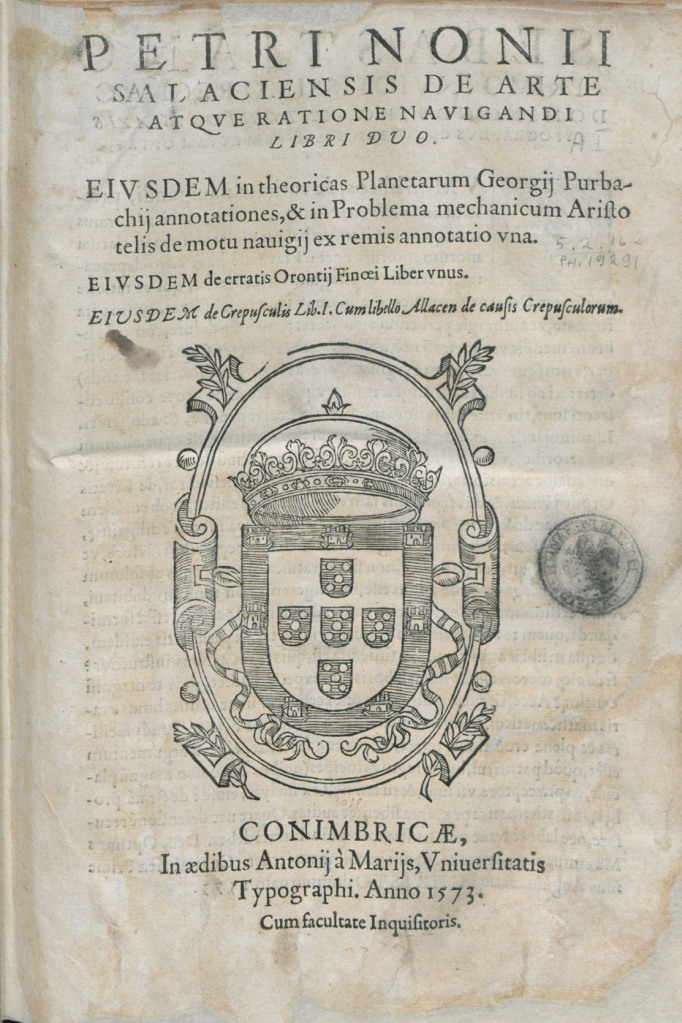
In 1538, the Portuguese government sent Nunes’ student, João de Castro (1500–1548), Chief Pilot of the Portuguese navy on a three-year voyage to the East Indies during which he made a survey of magnetic variation. In total he made forty-three accurate determinations, which varied wildly, and which totally blew João de Lisboa’s theory out of the water.
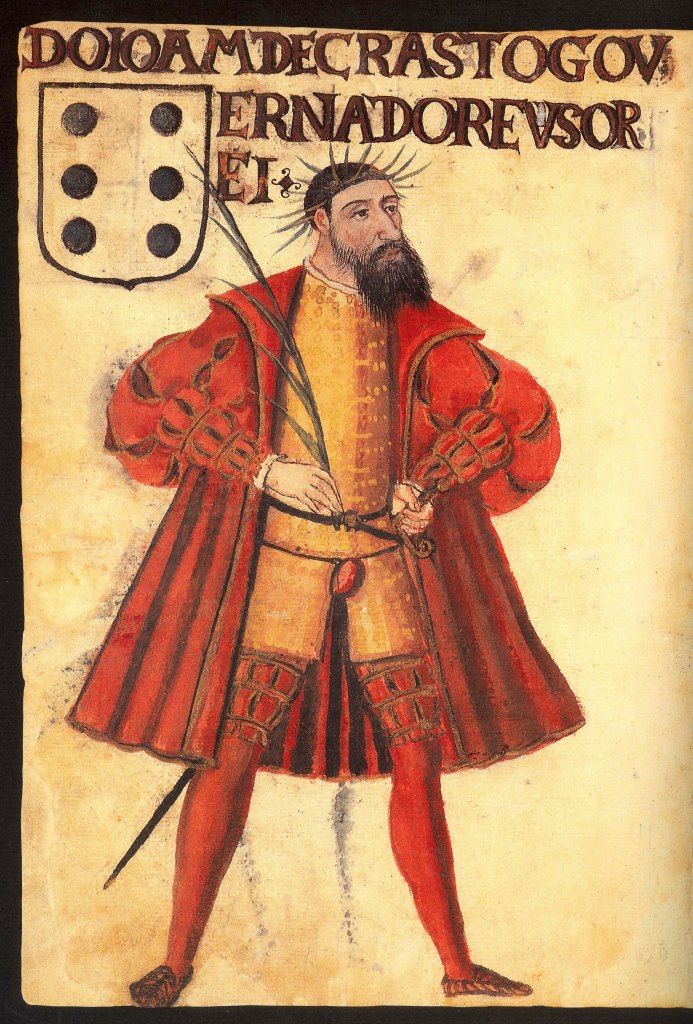
In 1545, the Spanish Royal Cosmographer, Pedro de Medina (1493–1567) published his Arte de Navegar (Art of Navigation) a widely used navigation manual, which maintained that compass needles pointed to the celestial poles and that variation was the product of operator or instrument error, at this point, a no longer viable argument. The Arte de Navegar (Art of Navigation), of his successor, Martin Cortés (1510–1582), published in 1551, and as we have already seen in earlier episodes the first navigation manual translated into English by Richard Eden (C. 1520–1576) in 1561, corrected Pedro de Medina’s view on variation.
In 1562, Jean Taisnier (1508–1562) a Wallonian musician, mathematician and astrologer, who taught in various European cities and universities and was the author of a number of cosmographical and divinatory texts, published an edition of Petrus Peregrinus’ Epistola de magnete together with the 1554 Demonstratio proportionum motuum localium (Treatise on the fall of bodies) by Giambattista Benedetti (1530–1590) under the title Opusculum perpetua memoria dignissimum, De Natura Magnetis et ejus effectibus, Item De Motu Continuo (A little work worthy of preservation, On the Nature of the Magnet and its Effects, and another On Perpetual Motion) without mentioning either author and with his own author portrait.
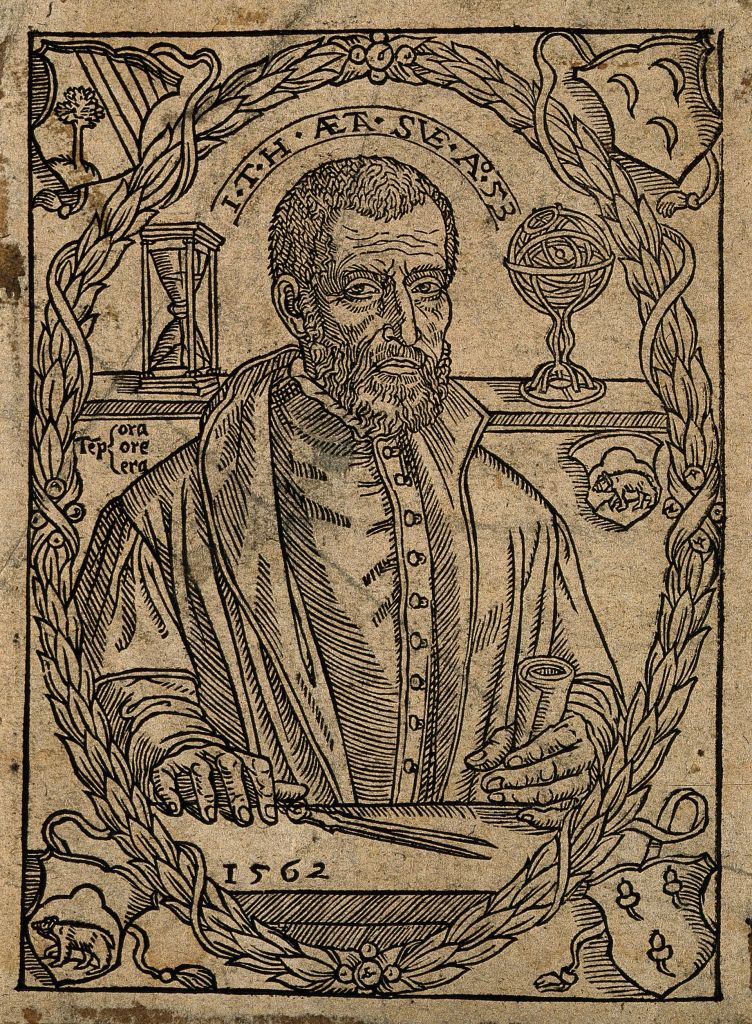
However, confusion still ruled on variation and its causes, as the English navigators and mathematici, who I shall be looking at in detail in future episodes of this series, began to tackle the problems of the magnet, magnetism, and the magnetic compass.
The quote I brought at the beginning of this essay from William Gilbert’s De magnete (1600), listing some but not all of the people I shall be dealing with, is followed by an incredible chauvinistic rant about the efforts of the Early Modern Europeans to make sense of magnetism, the compass, and variation some of which I have sketched above:
Many others I pass by of purpose: Frenchmen, Germans, and Spaniards of recent times who in their writings, mostly composed in their vernacular languages, either misuse the teachings of others, and like furbishers send forth ancient things dressed with ne names and tricked in an apparel of new words as in prostitutes’ finery; or who publish things not even worthy of record; who, pilfering some book, grasp for themselves from other authors, and go a-begging for some patron, or go a-fishing among the inexperienced and the young for a reputation; who seem to transmit from hand to hand, as it were, erroneous teachings in every science and out of their own store now and again to add somewhat of error.[5]
[1] I have to make the obligator comment that William Gilbert and I attended the same grammar school, he was a couple of year ahead of me.
[2] Will be explained soon!
[3] Will also be explained later.
[4] De Magnete by William Gilbert Translated by P. Fleury Mottelay, Dover Publications, NY, 1958, p. 14
[5] De magnete, details as in footnote 4 above, p. 14